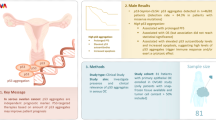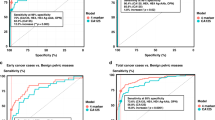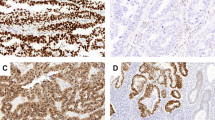Abstract
Serum autoantibodies against the p53 protein (p53 AAb) were analysed with a newly developed enzyme-linked immunosorbent assay (ELISA) based on highly purified and renatured p53. In a hospital-based cohort study, preoperative sera from 113 patients with ovarian cancer, 15 patients with borderline tumours and 117 patients with benign tumours of the ovaries were studied. The prevalence of p53 AAb in patients with invasive cancer was 19% (21/113). No p53 AAb were found in patients with borderline lesions or benign tumours. The ELISA had a specificity for malignancy of 99% (1 of 117; false-positive from a patient with severe diabetes mellitus) and a likelihood ratio (LR+) for a positive test result of 21.7 (elevated CA125 and malignancy: LR+ 3.7). p53 AAb were only detectable in patients with immunohistochemical staining of nuclear p53 in the tumour (P= 0.006). Presence of p53 AAb positively correlated with tumour stage (P= 0.034) and grade (P= 0.009). Kaplan–Meier analysis showed both a shortened overall survival (P= 0.0016, log-rank) and relapse-free survival (P= 0.055) for p53 AAb-positive patients (median follow-up 22 months). High titres related to even worse prognosis. p53 AAb independently related to poor survival adjusting for stage (P= 0.026), grade (P= 0.029) and residual disease after surgery (P= 0.005). Preoperative findings of adnexal mass with serum p53 AAb are strongly suggestive of an aggressive invasive ovarian cancer. © 2000 Cancer Research Campaign
Similar content being viewed by others
Article PDF
Change history
16 November 2011
This paper was modified 12 months after initial publication to switch to Creative Commons licence terms, as noted at publication
References
Angelopoulou K, Diamandis EP, Sutherland DJ, Kellen JA and Bunting PS (1994) Prevalence of serum antibodies against the p53 tumor suppressor gene protein in various cancers. Int J Cancer 58: 480–487
Angelopoulou K, Rosen B, Stratis M, Yu H, Solomou M and Diamandis EP (1996) Circulating antibodies against p53 protein in patients with ovarian carcinoma. Correlation with clinicopathologic features and survival. Cancer 78: 2146–2152
Angelopoulou K, Straits M and Diamandis EP (1997) Humoral immune response against p53 protein in patients with colorectal carcinoma. Int J Cancer 70: 46–51
Caron de Fromentel C, May-Levin F, Mouriesse H, Lemerle J, Chandrasekaran K and May P (1987) Presence of circulating antibodies against cellular protein p53 in a notable proportion of children with B-cell lymphoma. Int J Cancer 39: 185–189
Crawford LV, Pim DC and Bulbrook RD (1982) Detection of antibodies against the cellular protein p53 in sera from patients with breast cancer. Int J Cancer 30: 403–408
DePriest PD, Gallion HH, Pavlik EJ, Kryscio RJ and van Nagell JR Jr (1997) Transvaginal sonography as a screening method for the detection of early ovarian cancer. Gynecol Oncol 65: 408–414
Dottino PR, Levine DA, Ripley DL and Cohen CJ (1999) Laparoscopic management of adnexal masses in premenopausal and postmenopausal women. Obstet Gynecol 93: 223–228
Eltabbakh GH, Belinson JL, Kennedy AW, Biscotti CV, Casey G, Tubbs RR and Blumenson LE (1997) p53 overexpression is not an independent prognostic factor for patients with primary ovarian epithelial cancer. Cancer 80: 892–898
Gadducci A, Ferdeghini M, Buttitta F, Fanucchi A, Annicchiarico C, Prontera C, Bevilacqua G and Genazzani AR (1996) Preoperative serum antibodies against the p53 protein in patients with ovarian and endometrial cancer. Anticancer Res 16: 3519–3523
Gadducci A, Ferdeghini M, Buttitta F, Cosio S, Fanucchi A, Annicchiarico C and Genazzani AR (1998) Serum anti-p53 antibodies in the follow-up of patients with advanced ovarian carcinoma. Anticancer Res 18: 3763–3765
Gadducci A, Ferdeghini M, Buttitta F, Cosio S, Fanucchi A, Annicchiarico C, Gagetti O, Bevilacqua G and Genazzani AR (1999) Assessment of the prognostic relevance of serum anti-p53 antibodies in epithelial ovarian cancer. Gynecol Oncol 72: 76–81
Green JA, Robertson LJ, Campbell IR and Jenkins J (1995) Expression of the p53 gene and presence of serum autoantibodies in ovarian cancer: correlation with differentiation. Cancer Detect Prev 19: 151–155
Harris CC and Hollstein M (1993) Clinical implications of the p53 tumor-suppressor gene. N Engl J Med 329: 1318–1327
Hollstein M, Sidransky D, Vogelstein B and Harris CC (1991) p53 mutations in human cancers. Science 253: 49–53
Houbiers JG, van der Burg SH, van de Watering LM, Tollenaar RA, Brand A, van de Velde CJ and Melief CJ (1995) Antibodies against p53 are associated with poor prognosis of colorectal cancer. Br J Cancer 72: 637–641
Lai CL, Tsai CM, Tsai TT, Kuo BI, Chang KT, Fu HT, Perng RP and Chen JY (1998) Presence of serum anti-p53 antibodies is associated with pleural effusion and poor prognosis in lung cancer patients. Clin Cancer Res 4: 3025–3030
Lane DP (1992) Cancer. p53, guardian of the genome. Nature 358: 15–16
Legros Y, Lacabanne V, d'Agay MF, Larsen CJ, Pla M and Soussi T (1993) Production of human p53 specific monoclonal antibodies and their use in immunohistochemical studies of tumor cells. Bull Cancer 80: 102–110
Legros Y, Lafon C and Soussi T (1994) Linear antigenic sites defined by the B-cell response to human p53 are localized predominantly in the amino and carboxy-termini of the protein. Oncogene 9: 2071–2076
Lubin R, Schlichtholz B, Bengoufa D, Zalcman G, Tredaniel J, Hirsch A, de Fromentel CC, Preudhomme C, Fenaux P, Fournier G, Mangin P, Laurent-Pvig P, Pelletier G, Schlumberger M, Desgrandchamps F, Le Duc A, Peyrat JP, Janin N, Bressac B and Soussi T (1993) Analysis of p53 antibodies in patients with various cancers define B-cell epitopes of human p53: distribution on primary structure and exposure on protein surface. Cancer Res 53: 5872–5876
Lubin R, Schlichtholz B, Teillaud JL, Garay E, Bussel A and Wild CP (1995) p53 antibodies in patients with various types of cancer: assay, identification, and characterization. Clin Cancer Res 1: 1463–1469
Marks JR, Davidoff AM, Kerns BJ, Humphrey PA, Pence JC, Dodge RK, Clarke Pearson DL, Iglehart JD, Bast RC Jr and Berchuck A (1991) Overexpression and mutation of p53 in epithelial ovarian cancer. Cancer Res 51: 2979–2984
Milner BJ, Allan LA, Eccles DM, Kitchener HC, Leonard RC, Kelly KF, Parkin DE and Haites NE (1993) p53 mutation is a common genetic event in ovarian carcinoma. Cancer Res 53: 2128–2132
Mudenda B, Green JA, Green B, Jenkins JR, Robertson L, Tarunina M and Leinster SJ (1994) The relationship between serum p53 autoantibodies and characteristics of human breast cancer. Br J Cancer 69: 1115–1119
Nedbal W, Frey M, Willemann B, Zentgraf H and Sczakiel G (1997) Mechanistic insights into p53-promoted RNA-RNA annealing. J Mol Biol 266: 677–687
Peyrat JP, Bonneterre J, Lubin R, Vanlemmens L, Fournier J and Soussi T (1995) Prognostic significance of circulating P53 antibodies in patients undergoing surgery for locoregional breast cancer. Lancet 345: 621–622
Rohayem J, Conrad K, Zimmermann T and Frank KH (1999) Comparison of the diagnostic accuracy of three commercially available enzyme immunoassays for anti-p53 antibodies. Clin Chem 45: 2014–2016
Runnebaum IB, Kieback DG, Mobus VJ, Tong XW and Kreienberg R (1996) Subcellular localization of accumulated p53 in ovarian cancer cells. Gynecol Oncol 61: 266–271
Schlichtholz B, Legros Y, Gillet D, Gaillard C, Marty M, Lane D, Calvo F and Soussi T (1992) The immune response to p53 in breast cancer patients is directed against immunodominant epitopes unrelated to the mutational hot spot. Cancer Res 52: 6380–6384
Schlichtholz B, Tredaniel J, Lubin R, Zalcman G, Hirsch A and Soussi T (1994) Analyses of p53 antibodies in sera of patients with lung carcinoma define immunodominant regions in the p53 protein. Br J Cancer 69: 809–816
Soussi T and May P (1996) Structural aspects of the p53 protein in relation to gene evolution: a second look. J Mol Biol 260: 623–637
Vogl FD, Stickeler E, Weyermann M, T Kohler,, Grill H, Negri G, Kreienberg R and Runnebaum IB (1999) p53 autoantibodies in patients with primary ovarian cancer are associated with higher age, advanced stage and a higher proportion of p53-positive tumor cells. Oncology 57: 324–329
Wen W-H, Reles A, Runnebaum IB, Sullivan-Halley J, Bernstein L, Jones LA, Kreienberg R, El-Naggar A, Felix JC and Press MF (1999) p53 mutations and expression in ovarian cancers: Correlation with overall survival. Int J Gynecol Pathol 18: 29–41
Author information
Authors and Affiliations
Rights and permissions
From twelve months after its original publication, this work is licensed under the Creative Commons Attribution-NonCommercial-Share Alike 3.0 Unported License. To view a copy of this license, visit http://creativecommons.org/licenses/by-nc-sa/3.0/
About this article
Cite this article
Vogl, F., Frey, M., Kreienberg, R. et al. Autoimmunity against p53 predicts invasive cancer with poor survival in patients with an ovarian mass. Br J Cancer 83, 1338–1343 (2000). https://doi.org/10.1054/bjoc.2000.1446
Received:
Revised:
Accepted:
Published:
Issue date:
DOI: https://doi.org/10.1054/bjoc.2000.1446
Keywords
This article is cited by
-
Antibodies against Hsp60 and Hsp65 in the sera of women with ovarian cancer
Journal of Ovarian Research (2014)
-
Autoantibody biomarkers identified by proteomics methods distinguish ovarian cancer from non-ovarian cancer with various CA-125 levels
Journal of Cancer Research and Clinical Oncology (2013)
-
p53-autoantibody may be more sensitive than CA-125 in monitoring microscopic and macroscopic residual disease after primary therapy for epithelial ovarian cancer
Journal of Cancer Research and Clinical Oncology (2013)
-
Immunologic aspect of ovarian cancer and p53 as tumor antigen
Journal of Translational Medicine (2005)



